Fiat 500e is nothing short of electrifying
By John Gilbert
LOS ANGELES, CALIF. — The Fiat 500 is cute, fun, efficient, and economical, but nobody would really call it electrifying. Until now.
For 2014, the Fiat 500 will come in a version called the 500e, with the “e” standing for electric. Before consumers in 49 states get too excited about the 500e maybe becoming their electric car of choice, however, the car will require a little California Dreamin’ because the only showrooms it will reach in its initial launch will be in California.
The normal 500 has a distinct minicar look to it, and the designers and engineers have done an impressive job of smoothing out all the little quirks and wrinkles, spending 140 long hours in wind-tunnel testing to reduce the aerodynamic drag by 13 percent, to a 0.3111 coefficient of drag, said Brett Giem, who is chief engineer on the electric Fiat project. The smoothed-over frontal area makes it appear that a very sophisticated and high-class custom shop took the normal 500 and did a prize-winning job of altering it, leaving a unique look, but unmistakably a Fiat 500.
Inside that thoroughly revised bodywork, there is a structure and suspension strengthened and stiffened to optimize handling — the Fiat “fun” quotient — but something is missing. The small but effective little 4-cylinder engine with its clever MultiAir system that powers the normal Fiat 500, or the turbocharged version in the Fiat Abarth, are nowhere to be found, replaced by a powerful Bosch-supplied electric package, which consists of a liquid-cooled and heated 364-volt lithium-ion battery with 97 individual cells, created by Samsung. Computer wizards can figure out the equations, but the electric 500e develops 111 horsepower out of its 83 kilowatt electric motor, at 4,000 RPMs, with 147 foot-pounds of torque, which peaks at 0 RPMs.
Fiat, which now owns Chrysler LLC, is building the Fiat 500e in Toluca, Mexico, at the same plant where the regular 500 is being built, and the reasons for making the 500e available first in California includes: maximum demand for no-pollution alternative energy cars, an impressive array of rebates for electric cars, and an infrastructure of charging stations that set a standard for the rest of the country.
That doesn’t mean the 500e will be out of sorts in other regions. The development team did cold-weather testing in Bemidji, Minnesota; high-altitude testing in Denver; hot and dry weather tests in Las Vegas; varied weather and road surfaces in Michigan; and hot and humid testing in Naples, Florida. At the same time, Chrysler LLC was developing a climate-controlled test facility in California that can recreate desert heat, rainforest humidity, plus freezing rain and snow.
Electric cars and hybrids are carving out their own niches in the automotive world, with the critical difference coming in drivability, and range. Concerns about price seem reasonable, given that the Chevrolet Volt is over $40,000, and cars such as the Nissan Leaf and Ford Focus EV, which are the prime competition for the 500e, also cost more because of the expense of the electric motor system. The 500e costs $32,500, but starts out with a $7,500 federal tax credit, which reduces the price to a workable figure. The 500e is offered for a $199-per-month lease deal with $999 down, and there are other California rebate and incentive deals with zero-pollution cars that can be manipulated to create another lease deal of $169 a month with 0 down.
By the time the 500e migrates to the rest of the U.S., it will be more than just proven. Bosch, a German conglomerate, is responsible for combining the Samsung battery pack and all the complex elements into a powertrain unit that drops right into the Fiat 500. The battery pack adds weight, so it is located amidship, from under the front seat to the rear axle, and it improves the 500e’s weight distribution to a nearly neutral split of 52 percent front/48 percent rear.
An electric car’s range depends on how forcefully it is driven, and estimates for the 500e run up to and beyond 100 miles on a full charge. The range of an electric vehicle is right up there next to the price as major obstacles between futuristic performance and consumers who are gas-engine loyalists, it is also among the perplexing features of the car, right up there with horsepower, torque and miles per gallon — the traditional methods of judging a gas-engine’s power. One example is that stepping on the gas of the 500e delivers sudden response and startling acceleration. The numbers can be what they are, but the perception is more important than the statistics in this car’s case, and since the perception is that it is very quick, so it is.
Lou Rhodes, the “vehicle line executive” — which means he’s in charge of developing electric vehicles for Chrysler and therefore Fiat — rode with me and gave me several important tips, as we wound our way out of Beverly Hills and up into the foothills east of Los Angeles. “With a hybrid, you have to pay close attention to how you accelerate and how you brake and slow down,” said Rhodes. “With an electric car like the 500e, those things aren’t important. You can accelerate hard, and slow down as you choose, although the harder you drive the more you will reduce the range.”
Flexibility of the range is obvious from the first drive. On the first leg, I drove about 50 miles and the computerized information reported that we had remaining range of 50 miles. The computer showed me the equivalent of 101.1 miles per gallon — but, of course, we hadn’t used any gas. More important the remaining range of 50 more miles fit well into the 100-miles-plus calculations.
On the second leg, I drove exactly 47.9 more miles, against that 50-mile projection, which should have just about drained our available electric charge. But the curvy and uncongested roadways on the second leg were easier on power consumption, the instrument showed we still had 51 percent of our charge with a projected range of 46 more miles remaining. That means I drove 47.9 miles but consumed only 4 miles of the projected 50 miles of electric energy range.
That equated to 134.8 miles per gallon, which, again, is a number that has a real-world ring to it, but sounded alien to my already converted electricity-instead-of-gasoline brain. All I realized is that if you pay attention to your instruments, and your driving, you might be able to greatly extend your range. That would be something you would get comfortable with if you owned such a car and drove the same pattern to work and home every day.
The 500e has a one-speed transmission, but push-button selectors on the center stack of the dashboard that allows the driver to choose a preferred mode. The electric powertrain is warrantied for 8 years or 100,000 miles, and, of course, service and maintenance requirements are comparatively nonexistent, since normal things like oil changes are unnecessary, and brake jobs are greatly reduced because the electric motor does virtually all the braking down to 8 miles per hour.
From my brief test drive, and after Rhodes coaxed me to drive it harder, the 500e has a drivability quotient that is close to being, ah, electrifying. Typically, electric power is at its peak from zero, and while the 500e acceleration is not sensational with 0-60 mph coming in about 9 seconds, the car is remarkably quick from 0-30, before its initial blast of torque starts to spread out.
As for range, the 500e can carry its occupants over 100 miles in mostly urban driving, and 87 miles in sustained highway range. It can be totally charged when drained in less than 4 hours using the Level 2 on-board charging module, which sends a 240-volt charge into the battery, or more like 8 hours if using Level 1, which is normal household 120-volt.
“I love little cars, and new driving technology,” said Giem (which is pronounced “Gem” with a hard “G”). “But I never was a true convert to electric cars until I drove the first ‘e’ car. Then I could see how promising it is. We’ve taken our family on various drives, and with an 87-mile range, we’ve gone over 100 miles several times on a charge. When it’s cooler out, that might be reduced to 65-70 miles, and in severe cold it might be more like the mid-50-mile range. In severe cold, the 500e battery starts heating itself.”
Among the most amazing features is the regenerative braking. The electric motor spins during operation, and when you slow down or stop, the motor reverses polarity, becoming a generator, which does two things — servibng to slow the wheels down dramatically, while also converting kinetic energy to electricity to add charging to the lithium-ion-polymer battery. It’s impossible to detect any difference between normal hydraulic brakes and the reverse-motor regenerative braking, which works down to 8 mph, before the hydraulic brake system takes over. If there’s any variance in the traction on deceleration, the hydraulic disc brakes kick in, as well.
The most obvious feature of an electric car is its silent running. It takes off silently, and cruises silently. Too silently, Fiat engineers decided. So at a stoplight, the car emits a soft, subtle engine sound — “vaguely mechanical,” Giem said — just to alert pedestrians who might be unaware that an otherwise silent vehicle is headed their way. It took several tries before the engineers got the speakers aimed forward so the sound, small as it is, wouldn’t intrude on the interior solitude.
Typical of any electric-powered car, every imaginable electric feature works extremely well, whether it’s the premium Alpine 276-watt audio with six speakers, the automatic climate control, heated seats, or the hands-free communication technology. Seven airbags surround occupants in a cocoon of air cushions, and rear park assist and electronic stability control add to the security.
One more bit of security with the Fiat 500e is that in California, one outlet said the lowest price for regular gasoline in the Los Angeles area was $4.02 in the first week of April. Then consider that the EPA-estimated annual fuel-equivalent cost for electricity to power the 500e is $500. That’s about four tankfuls of gas in your full-sized SUV.
Comments
Tell me what you're thinking...
and oh, if you want a pic to show with your comment, go get a gravatar!


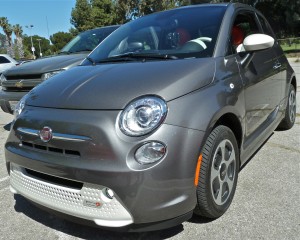
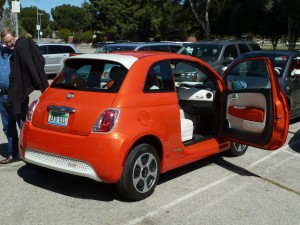
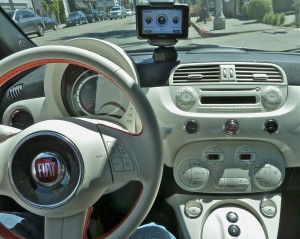
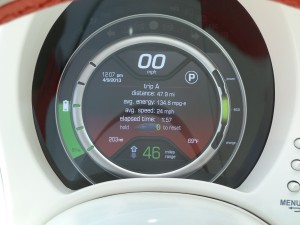
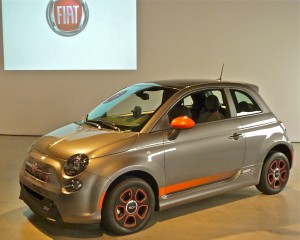
 John Gilbert is a lifetime Minnesotan and career journalist, specializing in cars and sports during and since spending 30 years at the Minneapolis Tribune, now the Star Tribune. More recently, he has continued translating the high-tech world of autos and sharing his passionate insights as a freelance writer/photographer/broadcaster. A member of the prestigious North American Car and Truck of the Year jury since 1993. John can be heard Monday-Friday from 9-11am on 610 KDAL(www.kdal610.com) on the "John Gilbert Show," and writes a column in the Duluth Reader.
John Gilbert is a lifetime Minnesotan and career journalist, specializing in cars and sports during and since spending 30 years at the Minneapolis Tribune, now the Star Tribune. More recently, he has continued translating the high-tech world of autos and sharing his passionate insights as a freelance writer/photographer/broadcaster. A member of the prestigious North American Car and Truck of the Year jury since 1993. John can be heard Monday-Friday from 9-11am on 610 KDAL(www.kdal610.com) on the "John Gilbert Show," and writes a column in the Duluth Reader.